Trailblazing Women of Australian Public Broadcasting 1945-1975
Kylie Andrews’ investigation into the ABC during its transition into television focusses on four trailblazing women producers – those whose job was to bring together programming ideas, technical production, and the sourcing of talent and locations. Andrews’ purpose was to uncover the unsung backroom women of ABC productions. While media production roles were considered at the time to be beyond women due to their technical nature, each of these four women proved this to be a fallacy.
READ REVIEW
↓
Trailblazing Women of Australian Public Broadcasting 1945-1975
Kylie andrews | 2022
The four women in this work are Kay Kinane, Catherine King, Therese Denny and Joyce Belfrage. They joined the ABC at different times in the post-war period but all experienced similar barriers to progression and professional development. Joyce Belfrage was an Englishwoman who had worked as a producer at the BBC and was married to a BBC newsreader. The other three were raised and educated in Australia, although all had gained experience overseas as broadcasters or producers.
The foundation of the ABC as a national broadcaster in the late 1940s and 1950s is a story of transitions, as it carved out roles within Australian society, found its own identity and became something of an oasis in what has been described as a ‘cultural desert’. It was essentially an organisation created by and managed by men.
Following the Second World War, women who had taken up jobs during the war were encouraged to return to home duties, with many barriers created for those working women who wished to undertake occupations other than caring and support roles, while preparing for motherhood and family responsibilities. Jobs as secretaries, stenographers, typists and script assistants were available to women at the ABC.
Andrews clearly outlines the policy of Australian broadcasters in both radio and television in the post-war period – news could only be read by a man, although there were some female presenters of other programs. Elizabeth Bond, for example, who joined the ABC in 1964, was the only female announcer among 32 men. Elizabeth was not allowed to read sports results, river heights and rainfall, agricultural matters, or the stock exchange results and never the news. Andrews also mentions Mary Rossi, the presenter of the ‘Women’s World’ television program from its inception in November 1956. Rossi was held up as an example of a woman who could do it all – she was married and had ten children. Working with producer Kay Kinane, she continued to present her program when she was pregnant.
Andrews uncovers useful strategies that women could employ to move beyond the professional barriers they encountered: strategies that are equally useful today. They include taking advantage of opportunities overseas to increase their knowledge and improve their résumé before returning to Australia; cultivating male mentors (named by Andrews as ‘ABC gatekeepers’), who could open doors or overrule barriers, as was done for several of the women in the book. Other approaches used by all of the women were to work across several platforms in the media industry; to go ‘under the radar’ to pursue their programming when managers were distracted by other changes and transitions in the industry; to take on risky or new formats or tasks; to be willing to fill gaps at short notice and in new areas, where there were insufficient trained staff; and to refuse to learn how to type so that there was no chance of being sent to the typing pool. As the author so rightly observes, once in the pool, the only escape was to move overseas or get married, which, up until 1966 in Australia, meant resigning from the ABC and the other public sector organisations.
The chapters in the work are themed, with the experiences of each woman examined within that theme. This detracts from the book’s readability. However, the work does begin with short biographies (called ‘Career Snapshots’) to introduce the women to the reader. Each came from an educated home; they were the daughters of politicians and public servants and the wives of broadcasters or academics. I checked the Australian Dictionary of Biography to see if any of the women had been listed, and found just one entry – for Catherine King, who was the daughter of well-known Australian academic Walter Murdoch and the wife of another academic, Alexander King. Andrews points out that the women were often only mentioned in news or print in relation to their fathers or husbands.
Despite all the barriers, the emergence of television did offer opportunities in the broadcasting field in Australia. As the ABC built its Gore Hill studios in Sydney, there was a make-shift community bringing this new media form to life, allowing some women to find a way into the male domain. The ABC developed television schools to which the four trailblazers contributed. In later years, they taught media studies at academic institutions such as Macquarie University.
For those readers interested in women’s history or media history in Australia, this is a fascinating book. While not in an easily readable format, Andrews has excellent notes and references to support each chapter, and a bibliography that provides a useful source of references for Australian media history.
Trailblazing Women of Australian Public Broadcasting 1945-1975 is published by Anthem Press.
Reviewer: Christina Ealing-Godbold, PHA (Qld)
*Should this blog continue? Reply to fbeddie@makeyourpoint.com.au or fpoulton@waybackwhen.com.au

